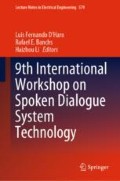Abstract
While in training, teachers are often given feedback about their teaching style by experts who observe the classroom. Trained observer coding of classroom such as the Classroom Assessment Scoring System (CLASS) provides valuable feedback to teachers, but the turnover time for observing and coding makes it hard to generate instant feedback. We aim to design technological platforms that analyze real-life data in learning environments and generate automatic objective assessments in real-time. To this end, we adopted state-of-the-art speech processing technologies and conducted trials in real-life teaching environments. Although much attention has been devoted to speech processing for numerous applications, few researchers have attempted to apply speech processing for analyzing activities in classrooms. To address this shortcoming, we developed speech processing algorithms that detect speakers and social behavior from audio recordings in classrooms. Specifically, we aim to infer the climate in the classroom from non-verbal speech cues. We extract non-verbal speech cues and low-level audio features from speech segments and train classifiers based on those cues. We were able to distinguish between positive and negative CLASS climate scores with 70–80% accuracy (estimated by leave-one-out crossvalidation). The results indicate the potential of predicting classroom climate automatically from audio recordings.
Access this chapter
Tax calculation will be finalised at checkout
Purchases are for personal use only
References
Pianta RC, La Paro KM, Hamre BK (2008) Classroom Assessment Scoring System™: manual K–3. Paul H Brookes Publishing
Donnelly PJ, Blanchard N, Olney AM, Kelly S, Nystrand M, D’Mello SK (2017) Words matter: automatic detection of teacher questions in live classroom discourse using linguistics, acoustics, and context. In: Proceedings of the 7th International Learning Analytics & Knowledge Conference, pp 218–227. ACM
Nystrand M (2004) CLASS 4.0 user’s manual
Donnelly PJ, Blanchard N, Samei B, Olney AM, Sun X, Ward B, Kelly S, Nystrand M, D’Mello SK (2016) Multi-sensor modeling of teacher instructional segments in live classrooms. In: Proceedings of the 18th ACM international conference on multimodal interaction, pp 177–184. ACM
Wang Z, Miller K, Cortina K (2013) Using the LENA in teacher training: promoting student involvement through automated feedback. Unterrichtswissenschaft 4
Wang Z, Pan X, Miller KF, Cortina KS (2014) Automatic classification of activities in classroom discourse. Comput. & Educ 78:115–123
Owens MT et al (2017) Classroom sound can be used to classify teaching practices in college science courses. Proc Natl Acad Sci 114(12):3085–3090
Anguera X, Bozonnet S, Evans N, Fredouille C, Friedland G, Vinyals O (2012) Speaker diarization: a review of recent research. IEEE Trans Audio, Speech, Lang Proc 20(2):356–370
Giannakopoulos T, Pikrakis A (2014) Introduction to audio analysis: a MATLAB approach. Academic Press, Oxford
Meignier S, Merlin T (2009) Lium Spkdiarization: an Open Source Toolkit for Diarization. In: CMU SPUD Workshop
Eyben F, Wollmer M, Schuller B (2010) Opensmile: the munich versatileand fast open-source audio feature extractor. In: Proceedings of the 18th ACM international conference on multimedia. ACM, pp 1459–1462
Sezgin MC, Gunsel B, Kurt GK (2012) Perceptual audio features for emotion detection. EURASIP J. Audio, Speech, Music Proc 1:16
Gunes H, Schuller B, Pantic M, Cowie R (2011) Emotion representation, analysis and synthesis in continuous space: a survey. In: Face and gesture, pp 827–834
Breiman L (2011) Random forests. Mach Learn 4(1):5–32
Hall MA (1999) Correlation-based feature selection for machine learning
Acknowledgements
This project is supported by a grant from Centre for Research and Development in Learning (CRADLE@NTU).
Author information
Authors and Affiliations
Corresponding author
Editor information
Editors and Affiliations
Rights and permissions
Copyright information
© 2019 Springer Nature Singapore Pte Ltd.
About this paper
Cite this paper
James, A. et al. (2019). Automated Classification of Classroom Climate by Audio Analysis. In: D'Haro, L., Banchs, R., Li, H. (eds) 9th International Workshop on Spoken Dialogue System Technology. Lecture Notes in Electrical Engineering, vol 579. Springer, Singapore. https://doi.org/10.1007/978-981-13-9443-0_4
Download citation
DOI: https://doi.org/10.1007/978-981-13-9443-0_4
Published:
Publisher Name: Springer, Singapore
Print ISBN: 978-981-13-9442-3
Online ISBN: 978-981-13-9443-0
eBook Packages: Literature, Cultural and Media StudiesLiterature, Cultural and Media Studies (R0)

